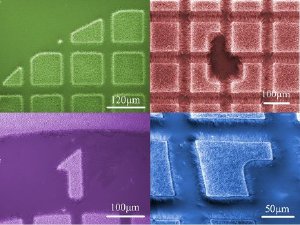Jan 14 2010
Boron nitride nanotubes (BNNTs) are the divas of the nanoworld. In possession of alluring properties, they are also notoriously temperamental compared to their carbon-based cousins.
 Carpets of boron nitride nanotubes grown on a substrate by Yoke Khin Yap's research group
Carpets of boron nitride nanotubes grown on a substrate by Yoke Khin Yap's research group
On the plus side, they can withstand incredibly high heat, well over 1,100 degrees Celsius, says Yoke Khin Yap, an associate professor of physics at Michigan Technological University. "Carbon nanotubes would burn like charcoal in a barbecue at half of those temperatures," he says. And the electrical properties of BNNTs are remarkably uniform. Perfect insulators, boron nitride nanotubes could be doped with other materials to form designer semiconductors that could be used in high-powered electronics.
Unfortunately, making nanotubes from boron and nitrogen is easier said than done. "Making carbon nanotubes is simpler, like cooking," says Yap. Boron nitride nanotubes, on the other hand, have always been fussy, requiring special instrumentation, dangerous chemistry, or temperatures of over 1,500 degrees Celsius to assemble. Even at that, the products are shot through with impurities.
"We've been stuck for more than 10 years because nobody could grow them well on substrates," says Yap. "But now we can."
As it turns out, boron nitride nanotubes just needed a little encouragement. Yap and his team have grown virtual Persian carpets of the tiny fibers on a substrate made from simple catalysts, magnesium oxide, iron or nickel. And they have managed it using the same instrumentation for growing carbon nanotubes, at about 1,100 degrees Celsius. And, their quality is perfect,.the present work. "I hope this encourages more researchers to grow BNNTs using the new technique," said Yap.
The boron nitride nanotubes can be made to assemble exclusively on these catalysts, so the researchers can control precisely where they grow. "You could write 'Michigan Tech' in nanotubes," says Yap.
These transparent nanotube sheets have another interesting property: they shed water like a duck's back, a quality known as the lotus effect. "Water just slides away," he says. "Anything coated with it would not only be stain resistant, it would be protected from anything water-soluble." This superhydrophobicity holds at all pH levels, so anything coated with it would be protected from even the strongest acids and alkalies.
The research was funded through a National Science Foundation Career Grant. A paper detailing Yap's discoveries, "Patterned Growth of Boron Nitride Nanotubes by Catalytic Chemical Vapor Deposition," has been published online by the journal Chemistry of Materials.
Yap is the editor of the book "B-C-N Nanotubes and Related Nanostructures," the first book on nanostructures constructed from one or multiple elements using boron, carbon, and nitrogen. He was the lead organizer of the Nanotubes and Related Nanostructures Symposium at the 2009 Materials Research Society Fall Meeting on.